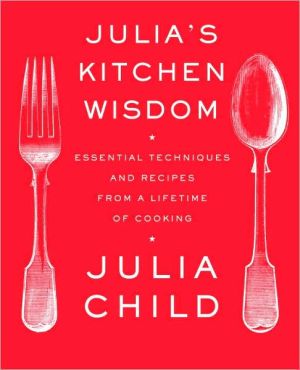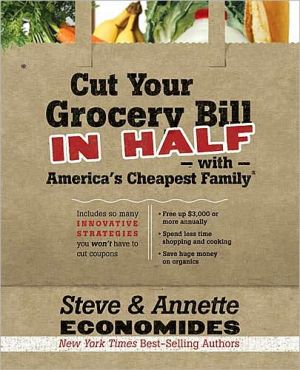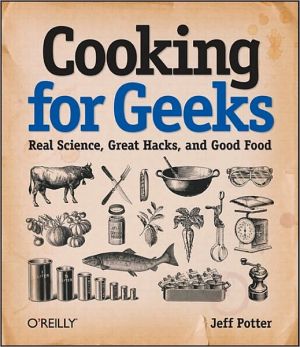In the Green Kitchen: Techniques to Learn by Heart
Alice Waters has been a champion of the sustainable, local cooking movement for decades. To Alice, good food is a right, not a privilege. In the Green Kitchen presents her essential cooking techniques to be learned by heart plus more than 50 recipes—for delicious fresh, local, and seasonal meals—from Alice and her friends. She demystifies the basics including steaming a vegetable, dressing a salad, simmering stock, filleting a fish, roasting a chicken, and making bread. An...
Search in google:
Alice Waters has been a champion of the sustainable, local cooking movement for decades. To Alice, good food is a right, not a privilege. In the Green Kitchen presents her essential cooking techniques to be learned by heart plus more than 50 recipes—for delicious fresh, local, and seasonal meals—from Alice and her friends. She demystifies the basics including steaming a vegetable, dressing a salad, simmering stock, filleting a fish, roasting a chicken, and making bread. An indispensable cookbook, she gives you everything you need to bring out the truest flavor that the best ingredients of the season have to offer. Contributors: Darina Allen • Dan Barber • Lidia Bastianich • Rick Bayless • Paul Bertolli • David Chang • Traci Des Jardins • Angelo Garro • Joyce Goldstein • Thomas Keller • Niloufer Ichaporia King • Peggy Knickerbocker • Anna Lappé & Bryant Terry • Deborah Madison • Clodagh McKenna • Jean-Pierre Moullé • Joan Nathan • Scott Peacock • Cal Peternell • Gilbert Pilgram • Clair Ptak • Oliver Rowe • Amaryll Schwertner • Fanny Singer • David Tanis • Poppy Tooker • Charlie Trotter • Jerôme Waag • Beth Wells The New York Times - Christine Muhlke There are instructions, but this isn't a manual. Rather, it's an interesting entry point for, say, the food-trending college graduate or the colleague who zaps Lean Cuisine at lunch while eyeing your leftover asparagus risotto—or even seasoned cooks who'd like to clear their counters of gadgets and re-enter a life where the salad is tossed by hand (better to feel the vinaigrette distribution), the biscuits are made with homemade baking powder (beyond easy) and all the mayonnaises are above average. In Alice's world, the Slow Food revolution begins at home.
David Chang's Salt & Sugar Pickles\ 4 servings\ David makes these pickles to be enjoyed right after seasoning, while they are still vibrant and crunchy.\ \ 3 very large radishes\ 2 thin daikon radishes\ 2 thin-skinned cucumbers with few seeds\ 2 pounds seedless watermelon\ 1 teaspoon fine sea salt\ 1 teaspoon sugar\ \ Prepare the vegetables and fruit and arrange in separate bowls; there should be about 1 1/2 cups of each kind. Halve the radishes and slice into thin wedges. Cut the daikon radishes crosswise into slices about 1/8 inch thick. Cut the cucumbers crosswise into slices about 1/4; inch thick. Remove the rind of the watermelon and cut the flesh into slices 1/3 inch thick and then into 2-inch wedges.\ In a small bowl, combine the salt and sugar, and sprinkle 1/2 teaspoon of the mixture over each vegetable and the watermelon and toss. Let the pickles stand for 5 to 10 minutes, arrange separately on a platter, and serve immediately.
\ Publishers WeeklyWaters, restaurateur and chef extraordinaire, showcases basic cooking techniques every cook can and should master along with recipes using each method in this slim and attractive book. Derived from a Slow Food Nation event she helped organize, where notable chefs and foodies provided demonstrations on foundational procedures, Waters highlights a set of techniques that are universal to all cuisines. She covers the most basic of the basics, from stocking the pantry and washing lettuce to boiling pasta and wilting greens. In typical Waters fashion, recipes showcase just a few simple ingredients, allowing the natural flavors of the food to shine. Since dishes were chosen to highlight process, the result is a somewhat eclectic grouping of recipes, including pesto; spaghettini with garlic, parsley, and olive oil; dirty rice; Irish soda bread; and apple galette. She also covers peeling tomatoes, skinning peppers, roasting vegetables, and roasting and carving chicken. Throughout are color photographs of demonstrators from the event including Lidia Bastianich, Traci Des Jardins, Dan Barber, and David Chang, among others. Ideal for the cooking novice, this gem of a book captures the expertise of world-class chefs in an accessible, straightforward manner. (May)\ \ \ \ \ Library JournalSlow Food Nation, a 2008 event in San Francisco founded by Waters, brought together people interested in food and a sustainable future. This book is the result of Waters's invitation to 30 chefs—famous and unknown, including Lidia Bastianich, Dan Barber, and David Chang—to demonstrate simple but necessary cooking techniques at the event. The chefs made mayonnaise, guacamole, and poached eggs, and Thomas Keller roasted a chicken. The featured skills are accompanied by the chefs' recipes with comments from Waters. Waters also lists the tenets of the "Green Kitchen Manifesto," e.g., "Setting the table and eating together teaches essential values to our children." Some of the 30 lessons are available online at alicewatersgreenkitchen.com. VERDICT This is another fine cookbook by a well-respected chef and author. Highly recommended for fans of Slow Food Nation.—Christine Bulson, SUNY at Oneonta Lib.\ \ \ Christine MuhlkeThere are instructions, but this isn't a manual. Rather, it's an interesting entry point for, say, the food-trending college graduate or the colleague who zaps Lean Cuisine at lunch while eyeing your leftover asparagus risotto—or even seasoned cooks who'd like to clear their counters of gadgets and re-enter a life where the salad is tossed by hand (better to feel the vinaigrette distribution), the biscuits are made with homemade baking powder (beyond easy) and all the mayonnaises are above average. In Alice's world, the Slow Food revolution begins at home.\ —The New York Times\ \








